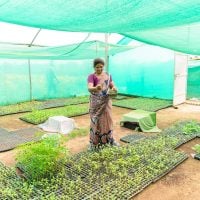Livelihood development grants play a crucial role in empowering individuals and communities, particularly in impoverished areas. These grants are designed to provide financial support for initiatives that enhance the economic stability and self-sufficiency of vulnerable populations. By focusing on sustainable development, these grants not only address immediate financial needs but also foster long-term growth and resilience.
The importance of these grants cannot be overstated, as they serve as a catalyst for change, enabling communities to break the cycle of poverty and build a better future for themselves. Moreover, livelihood development grants often target specific sectors such as agriculture, small business development, and vocational training. This targeted approach ensures that the funds are utilized effectively, addressing the unique challenges faced by different communities.
For instance, in rural areas where agriculture is the primary source of income, grants can be used to improve farming techniques, access to markets, and overall productivity. In urban settings, grants may support entrepreneurship and skill development, allowing individuals to create their own job opportunities. By investing in these areas, livelihood development grants not only uplift individuals but also contribute to the overall economic growth of communities.
Eligibility and Application Process for Livelihood Development Grants
Meeting the Eligibility Criteria
The eligibility criteria for livelihood development grants are often based on factors such as the target population, the proposed project’s alignment with the grantor’s mission, and the applicant’s capacity to manage funds effectively. Organizations must demonstrate a track record of successful project implementation and a clear understanding of the community’s needs to qualify for these grants.
The Application Process: A Competitive and Intricate Journey
The application process for livelihood development grants can be complex and competitive. Applicants are usually required to submit a detailed proposal outlining their project objectives, methodologies, expected outcomes, and budgetary needs. It is essential to articulate how the proposed project aligns with the funder’s goals and how it will benefit the community.
Tips for Success: Research, Tailor, and Ensure Accuracy
To increase their chances of securing funding, applicants should invest time in researching potential funders, tailoring their proposals to meet specific requirements, and ensuring that all documentation is complete and accurate. Additionally, many grantors require evidence of community involvement and support, which can be demonstrated through letters of endorsement or partnerships with local organizations.
Impact of Livelihood Development Grants on Impoverished Communities
The impact of livelihood development grants on impoverished communities can be profound and far-reaching. By providing financial resources for skill development, entrepreneurship, and sustainable practices, these grants enable individuals to improve their economic circumstances significantly. For example, a community that receives funding for vocational training can see a marked increase in employment rates as individuals acquire new skills that make them more competitive in the job market.
This not only benefits the individuals but also contributes to the overall economic health of the community. Furthermore, livelihood development grants often lead to enhanced social cohesion within communities. As individuals engage in collective projects or businesses funded by these grants, they build relationships and networks that strengthen community ties.
This sense of unity can lead to increased collaboration on other initiatives, fostering an environment where community members support one another in their endeavors. The ripple effect of these grants can transform entire communities, creating a culture of empowerment and resilience that extends beyond mere financial assistance.
Examples of Successful Livelihood Development Projects Supported by Grants
Numerous successful livelihood development projects illustrate the transformative power of grants in impoverished communities. One notable example is a microfinance initiative in Bangladesh that provided small loans to women entrepreneurs. With access to capital, these women were able to start their own businesses, ranging from handicrafts to food production.
The success of this program not only improved the financial stability of these women but also empowered them within their households and communities. As they became financially independent, they gained greater decision-making power and contributed to their families’ well-being. Another compelling case is found in rural India, where a grant-funded project focused on sustainable agriculture practices.
Farmers received training on organic farming techniques and were provided with resources to implement these methods. As a result, crop yields increased significantly while reducing dependency on chemical fertilizers and pesticides. This project not only improved food security for the farmers but also opened up new markets for organic produce, enhancing their income potential.
Such examples underscore how targeted livelihood development grants can lead to sustainable change and uplift entire communities.
Challenges and Opportunities in Implementing Livelihood Development Grants
While livelihood development grants offer significant opportunities for growth and empowerment, implementing these projects is not without its challenges. One major hurdle is ensuring that the funds are used effectively and reach the intended beneficiaries. Mismanagement or lack of transparency can undermine the impact of these grants and erode trust within communities.
Additionally, cultural barriers may hinder participation in certain programs, particularly if they do not align with local customs or practices. It is essential for organizations to engage with community members throughout the planning and implementation phases to ensure that projects are culturally sensitive and relevant. On the flip side, these challenges also present opportunities for innovation and collaboration.
Organizations can leverage technology to enhance transparency and accountability in fund management. For instance, using mobile applications for tracking expenditures can provide real-time insights into how funds are being utilized. Furthermore, fostering partnerships with local stakeholders can enhance project relevance and sustainability.
By working together with community leaders, businesses, and other NGOs, organizations can create a more comprehensive approach to livelihood development that addresses multiple facets of poverty alleviation.
Future Outlook for Livelihood Development Grants in Impoverished Areas
Increased Recognition of Sustainable Solutions
As global challenges such as climate change and economic inequality become more pronounced, there is an increasing recognition of the need for sustainable solutions that empower communities at the grassroots level. This shift in focus is likely to result in more funding opportunities dedicated specifically to livelihood development initiatives.
The Role of Technology in Shaping the Future
Advancements in technology are expected to play a significant role in shaping the future of these grants. Digital platforms can facilitate better communication between funders and recipients, streamline application processes, and enhance monitoring and evaluation efforts. As organizations become more adept at utilizing data analytics, they will be able to assess the impact of their projects more effectively and make informed decisions about future funding allocations.
A Robust Ecosystem of Support
Ultimately, as more stakeholders recognize the value of investing in livelihoods as a means of poverty alleviation, we can anticipate a more robust ecosystem of support for those striving to improve their economic circumstances in impoverished areas.









































